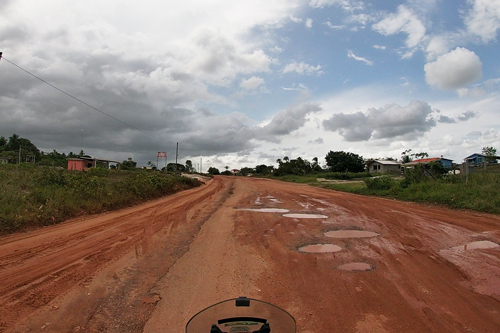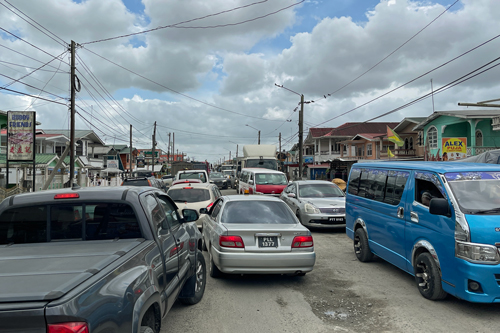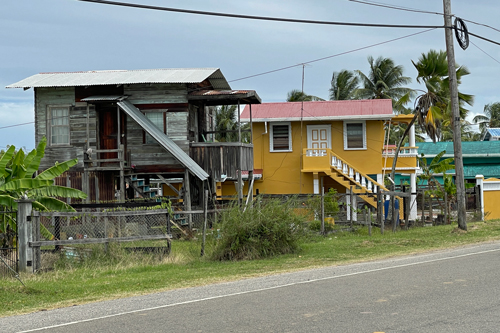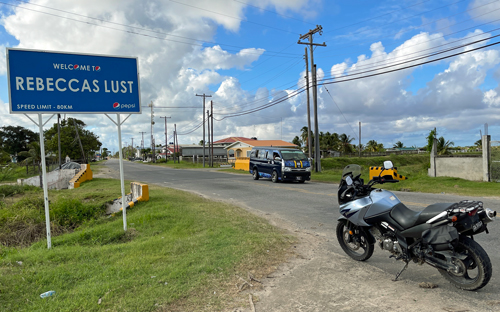There aren’t many places to ride a motorcycle in Guyana – at least, not many that aren’t slewed with pot-holes, or slathered with mud. The country seems like an afterthought in South America. More than 90 per cent of Guyana, tucked up against the north-east coast, is covered with rain forest or jungle – who’d go there for a road trip?
Well, me. My wife and I have friends who live there, and we wanted to go visit for a couple of weeks. And if I was going to visit, I wanted to explore on a motorcycle.

I rented an older Suzuki 650 V-Strom from a guy who was trying to sell it on Facebook, and hoped for the best. It had no collision insurance – “no motorcycles carry it here,” he told me. “You’ll see why” – and we agreed on a handshake that I’d pay for any damage, with an upper limit of $3,000 to buy it if it was wrecked. Deal!
There are basically three paved highways in the country, which head west, east, and south out of the capital, Georgetown. There are many dirt roads too, including a 400-kilometre stretch south that is the main road to Brazil, but the tropical rains turn them into quagmires and the Suzuki’s tires would slip badly. And I’d get filthy and exhausted. I’d stay on the asphalt.

Headed west on the first day, I rode straight into the trial by fire of the downtown capital. Drivers jostled for space on the pot-holed roads but there was some order to the apparent chaos. The minibuses had right of way because their drivers just didn’t care – if the bus’s 15 seats weren’t full, they’d collect passengers beside the road and they’d swerve and brake to pick them up. Bigger vehicles also had the right of way because, well, they’re bigger. And other motorcycles were constantly threading through the traffic to push to the front, so watch out for them.

Basically, if there was space to move, everybody else had the right of way. Once I understood and accepted this, riding was simple. Besides, my 650 was one of the largest and most powerful motorcycles in the country, so there was nothing to prove. I was on vacation. Relaxed. No hurry.
There’s only one bridge across the wide Demerara River that cleaves the country down the middle. The capital city sits on the east bank where it empties into the ocean and if you want to reach anywhere by road that’s west, you must cross the bridge – a floating structure only designed to last 10 years when it was built in 1978. It’s worth it, though. On the other side, the two-lane road runs along the coast and gave a chance to open up the bike a little until it reached the next wide river an hour away.

You can’t see the ocean, and there aren’t any beaches or resorts. Much of the coastal land is below sea level, and there’s a thick concrete-and-rock wall that protects it from flooding. When you can see over to the north, the water is brown from sediment washed out by the enormous rivers that help to drain the vast Amazon basin. Most of the houses are built on stilts to keep them above the damp ground, though drainage ditches with dykes help to regulate the water levels.
I turned around at the river, in the market town of Parika. There’s no bridge, just a ferry, and the road on the other side peters out into the jungle after an hour. Instead, I rode back and over the bridge to Georgetown, victorious, and oiled the chain for the next ride a couple of days later out to the east.

This is the wider road that follows the coast to Surinam, which is Guyana’s poorer neighbour. It would only be a day trip, so I revved the Suzuki, more confident this time, and rode east. Traffic was light and I made sure to give the occasional minibuses a wide berth; with some distance under my tires and the warm wind blowing through my mesh jacket, the ride would be relaxing – a welcome break from the city.
The highway passed through numerous small communities, barely discernible from each other with strange names announced on large roadside signs: Letter Kenny, Rebecca’s Lust, #69 Friendship, Adventure. All seemed to have the same ornate houses on stilts, and hardware stores, and open restaurants serving beer, and they were separated by flat arable fields with drainage ditches and mangrove stands over near the hidden ocean.

At the town of Buxton, there was thick smoke rising into the sky, and as I rode closer, I saw it seemed to come from a truck on fire in the road. Debris littered the area. People yelled at me to turn around, so I did and found a route past on dirt roads before regaining the highway. The road was still lightly travelled so I rode on to the river border with Surinam, where I turned around again for the ride home. This time, I rode through several police checkpoints where I was waved on without needing to stop. Back at Buxton, the highway was coated with scorched rubber; police and soldiers were everywhere, watching traffic, barely noticing me on the big silver motorcycle.

When I reached my friends’ home in the capital, my wife was upset. I’d turned off my phone, so didn’t see her text from hours earlier: “You need to get back to Georgetown,” she’d written. “There are riots in Buxton. Everyone here is concerned about you. Please don’t make this awkward. Just come back.”
Apparently, a popular small-time drug dealer named “The Godfather” had been chased in his car by armed police, who forced him into the ditch at Buxton and arrested him. The townspeople came out in support, angry that the police had shot up the place over a few bags of marijuana, and they torched an unfortunate truck that just happened to be there. The army came in to regain control, shots were fired, and then I rode through, relaxed, waving happily at everyone who waved at me.
“I don’t know how you get yourself into these situations,” said my wife, exacerbated.

I do. I just make sure to get out there and explore, and if I can do so on a motorcycle, when I’m not insulated behind a metal door and a window, then all the better.
I returned the Suzuki a week later with an extra 500 miles on its odometer, and no fresh scratches or dents to augment the ones it carried already. I think the owner was a little disappointed that I didn’t buy it. So was I, to be honest. It would be great to have a motorcycle in Guyana for next winter, maybe with some knobby tires to explore that road down to Brazil. Now that will be an adventure.



